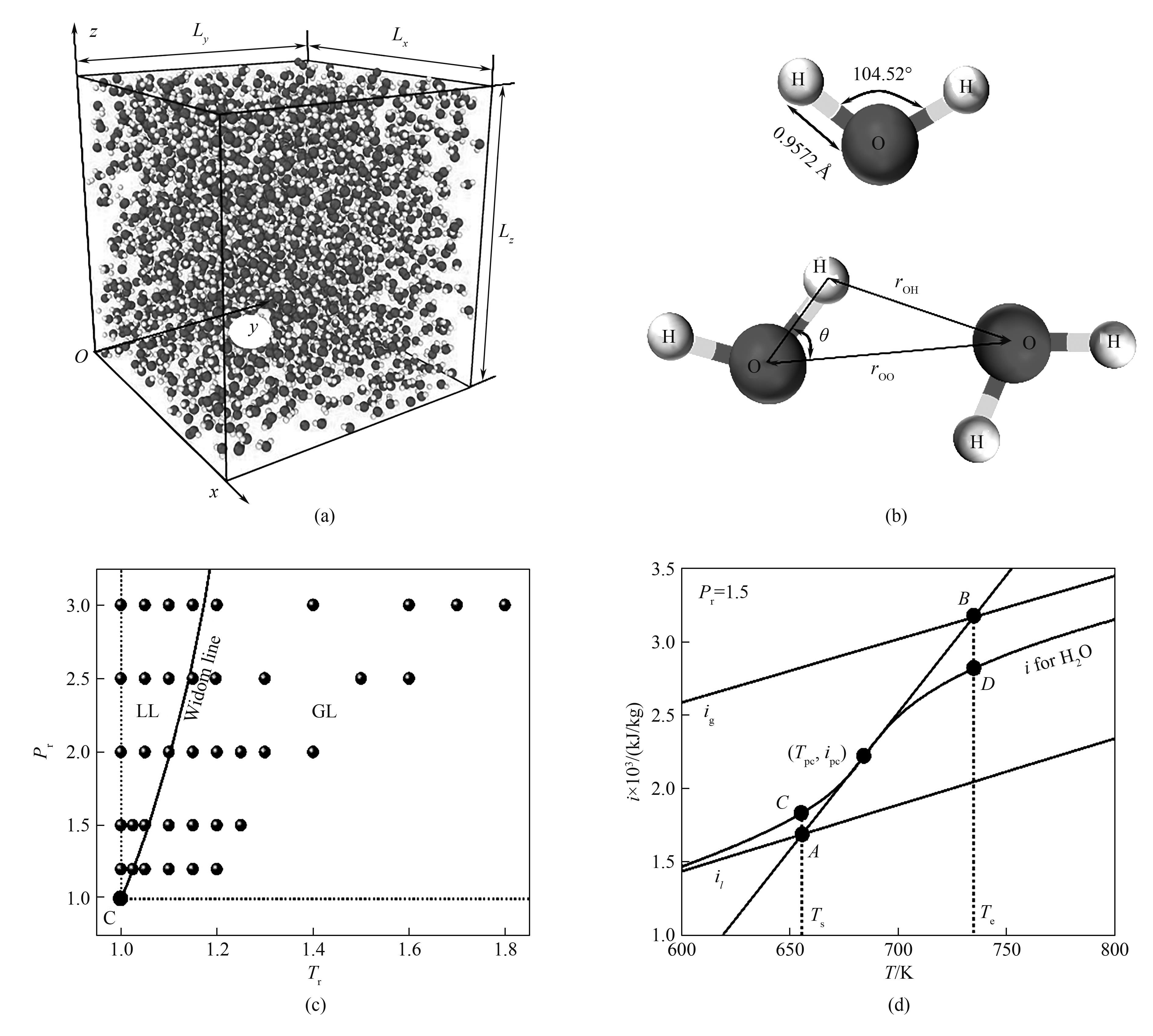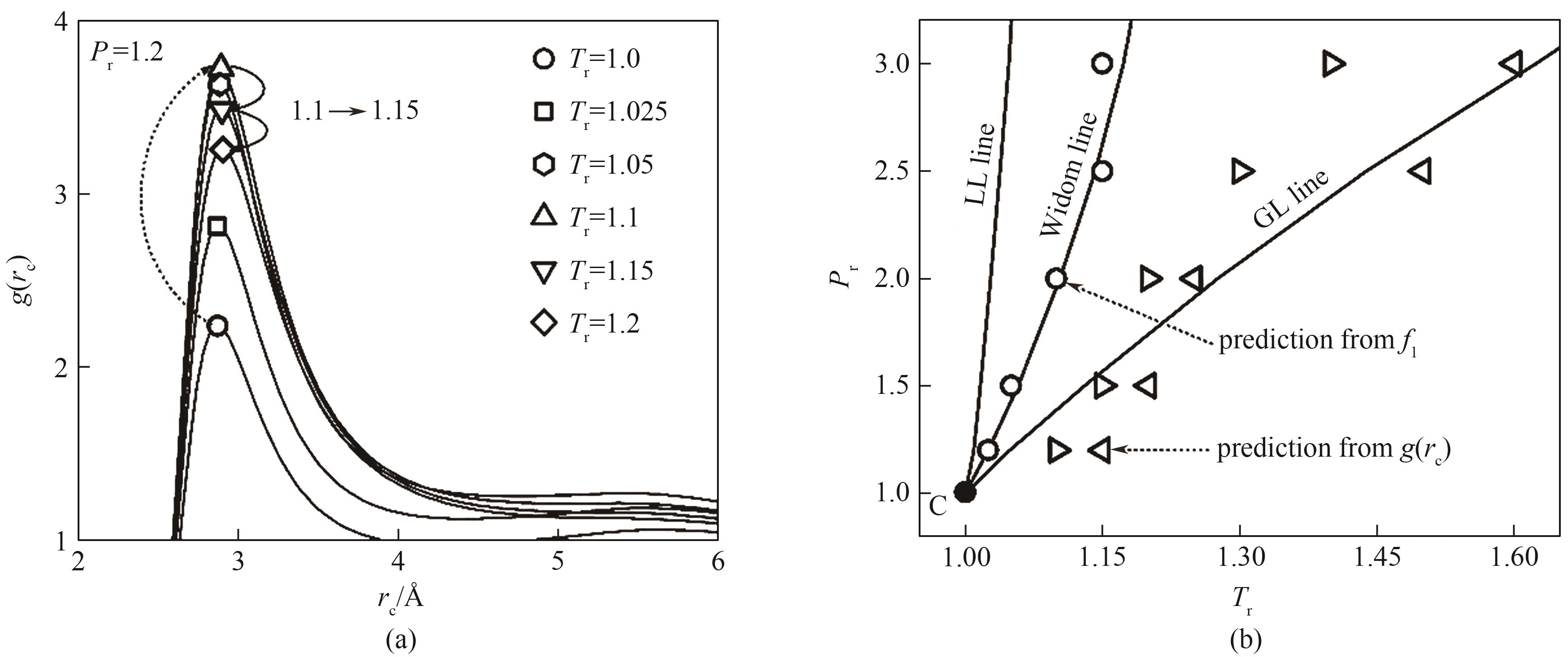化工学报 ›› 2023, Vol. 74 ›› Issue (7): 2836-2847.DOI: 10.11949/0438-1157.20230398
收稿日期:2023-04-26
修回日期:2023-06-14
出版日期:2023-07-05
发布日期:2023-08-31
通讯作者:
徐进良
作者简介:董明(1997—),男,博士研究生,dongmingjh@163.com
基金资助:
Ming DONG1( ), Jinliang XU1,2(
), Jinliang XU1,2( ), Guanglin LIU1
), Guanglin LIU1
Received:2023-04-26
Revised:2023-06-14
Online:2023-07-05
Published:2023-08-31
Contact:
Jinliang XU
摘要:
为深入理解超临界流体的非均质特性,采用分子动力学模拟对宽广温压参数下超临界水的氢键结构、物理结构及动力学性质的演化规律进行分析。结果表明,同一压力下超临界水中二聚体数量的转折点代表类液相到类气相的过渡,径向分布函数第一峰峰值的转折点代表类两相到类气相的过渡,分别与Widom线和类气线相对应。根据超临界水的平均氢键数、物理结构如近邻分子数以及动力学性质如扩散和旋转运动在类液相和类气相区域的显著差异,确定了超临界水类两相区域的边界位置,与热力学方法得到结果吻合良好。研究从分子层面揭示超临界水非均质特性的演化规律,表明超临界水具有多相特征,存在类液、类两相和类气区域,为超临界流体流动及传热应用提供理论支撑。
中图分类号:
董明, 徐进良, 刘广林. 超临界水非均质特性分子动力学研究[J]. 化工学报, 2023, 74(7): 2836-2847.
Ming DONG, Jinliang XU, Guanglin LIU. Molecular dynamics study on heterogeneous characteristics of supercritical water[J]. CIESC Journal, 2023, 74(7): 2836-2847.

图1 (a) 物理模型图;(b) 氢键判定示意图;(c) 模拟工况图;(d) 热力学方法确定TPL区的起始温度Ts和终止温度Te(计算方法参考文献[18])
Fig.1 (a) Physical model of system; (b) Hydrogen bonding determination criteria; (c) Simulation points on phase diagram; (d) Ts and Te determined by thermodynamic method

图2 (a) TIP4P/2005模型的模拟密度与实验密度比较;(b) NVT系综下的模拟压力与设定压力比较
Fig.2 (a) Density from TIP4P/2005 model and experimental; (b) Simulated pressure from NVT ensemble and set pressure

图5 (a) Pr=1.2时水分子中氧原子径向分布函数g(rc)曲线;(b) 根据f1及g(rc)确定Widom线及GL线
Fig.5 (a) The curve of g(rc)-rc under Pr=1.2; (b) Widom line and GL line determined by f1 and g(rc)

图6 (a) 根据TWF近邻法(ngas-N)划分LL、TPL和GL相区域;(b) 根据Voronoi多边形法(ngas-ρc)划分LL、TPL和GL相区域;(c) LL和GL分子的空间相分布
Fig.6 (a) LL, TPL, and GL regions determined by TWF neighborhood method (ngas-N); (b) LL, TPL, and GL regions determined by Voronoi diagram method(ngas-ρc); (c) Spatial phase distribution of LL and GL molecules

图8 (a) Pr=1.2时旋转与扩散系数比αrot/trans随温度变化;(b) 根据αrot/trans划分LL、TPL和GL相区
Fig.8 (a) The curve of αrot/trans-Tr under Pr=1.2; (b) LL, TPL, and GL regions determined by αrot/trans
| 1 | Berche B, Henkel M, Kenna R. Critical phenomena: 150 years since Cagniard de la Tour[J]. Journal of Physical Studies, 2009, 13(3): 3001. |
| 2 | Rahman M M, Ji D X, Beni M S, et al. Supercritical water heat transfer for nuclear reactor applications: a review[J]. Annals of Nuclear Energy, 2016, 97: 53-65. |
| 3 | Ahn Y, Bae S J, Kim M, et al. Review of supercritical CO2 power cycle technology and current status of research and development[J]. Nuclear Engineering and Technology, 2015, 47(6): 647-661. |
| 4 | Hobbs H R, Thomas N R. Biocatalysis in supercritical fluids, in fluorous solvents, and under solvent-free conditions[J]. Chemical Reviews, 2007, 107(6): 2786-2820. |
| 5 | Qian L L, Wang S Z, Xu D H, et al. Treatment of municipal sewage sludge in supercritical water: a review[J]. Water Research, 2016, 89: 118-131. |
| 6 | Brunner G. Near critical and supercritical water (Part Ⅰ): Hydrolytic and hydrothermal processes[J]. The Journal of Supercritical Fluids, 2009, 47(3): 373-381. |
| 7 | Cengel Y A, Boles M A. Thermodynamics: An Engineering Approach[M]. New York: McGraw-Hill Education, 1989: 118-122. |
| 8 | Cabaco M I, Longelin S, Danten Y, et al. Local density enhancement in supercritical carbon dioxide studied by Raman spectroscopy[J]. The Journal of Physical Chemistry A, 2007, 111(50): 12966-12971. |
| 9 | Skarmoutsos I, Dellis D, Samios J. The effect of intermolecular interactions on local density inhomogeneities and related dynamics in pure supercritical fluids. A comparative molecular dynamics simulation study[J]. The Journal of Physical Chemistry B, 2009, 113(9): 2783-2793. |
| 10 | Widom B. Equation of state in the neighborhood of the critical point[J]. The Journal of Chemical Physics, 1965, 43(11): 3898-3905. |
| 11 | Simeoni G G, Bryk T, Gorelli F A, et al. The Widom line as the crossover between liquid-like and gas-like behaviour in supercritical fluids[J]. Nature Physics, 2010, 6(7): 503-507. |
| 12 | Brazhkin V V, Fomin Y D, Lyapin A G, et al. Widom line for the liquid-gas transition in Lennard-Jones system[J]. The Journal of Physical Chemistry B, 2011, 115(48): 14112-14115. |
| 13 | Losey J, Sadus R J. The Widom line and the Lennard-Jones potential[J]. The Journal of Physical Chemistry B, 2019, 123(39): 8268-8273. |
| 37 | Allen M P, Tildesley D J. Computer Simulation of Liquids[M]. 2nd ed. Oxford: Oxford University Press, 2017: 130-144. |
| 38 | Plimpton S. Fast parallel algorithms for short-range molecular dynamics[J]. Journal of Computational Physics, 1995, 117(1): 1-19. |
| 39 | Skarmoutsos I, Henao A, Guardia E, et al. On the different faces of the supercritical phase of water at a near-critical temperature: pressure-induced structural transitions ranging from a gaslike fluid to a plastic crystal polymorph[J]. The Journal of Physical Chemistry B, 2021, 125(36): 10260-10272. |
| 40 | Han S. Anomalous change in the dynamics of a supercritical fluid[J]. Physical Review E, 2011, 84(5): 051204. |
| 41 | Losey J, Sadus R J. Structural behavior of fluids from the vapor and liquid region to the supercritical phase[J]. Physical Review E, 2019, 100(5): 052132. |
| 42 | Chakraborty D, Chandra A. An analysis of voids and necks in supercritical water[J]. Journal of Molecular Liquids, 2011, 163(1): 1-6. |
| 43 | Gallo P, Corradini D, Rovere M. Widom line and dynamical crossovers as routes to understand supercritical water[J]. Nature Communications, 2014, 5: 5806. |
| 44 | Bhide S Y, Berkowitz M L. Structure and dynamics of water at the interface with phospholipid bilayers[J]. The Journal of Chemical Physics, 2005, 123(22): 224702. |
| 45 | Wang B B, Wang X D, Wang T H, et al. Enhancement of boiling heat transfer of thin water film on an electrified solid surface[J]. International Journal of Heat and Mass Transfer, 2017, 109: 410-416. |
| 46 | Bolmatov D, Brazhkin V V, Trachenko K. Thermodynamic behaviour of supercritical matter[J]. Nature Communications, 2013, 4: 2331. |
| 47 | Cockrell C, Brazhkin V V, Trachenko K. Transition in the supercritical state of matter: review of experimental evidence[J]. Physics Reports, 2021, 941: 1-27. |
| 14 | Brazhkin V V, Fomin Y D, Lyapin A G, et al. Two liquid states of matter: a dynamic line on a phase diagram[J]. Physical Review E, 2012, 85(3): 031203. |
| 15 | Yang C, Brazhkin V V, Dove M T, et al. Frenkel line and solubility maximum in supercritical fluids[J]. Physical Review E, 2015, 91: 012112. |
| 16 | Fomin Y D, Ryzhov V N, Tsiok E N, et al. Dynamical crossover line in supercritical water[J]. Scientific Reports, 2015, 5: 14234. |
| 17 | Brazhkin V V, Lyapin A G, Ryzhov V N, et al. Where is the supercritical fluid on the phase diagram?[J]. Physics-Uspekhi, 2012, 55(11): 1061-1079. |
| 18 | Banuti D T. Crossing the Widom-line - supercritical pseudo-boiling[J]. The Journal of Supercritical Fluids, 2015, 98: 12-16. |
| 19 | Heyes D M, Woodcock L V. Critical and supercritical properties of Lennard-Jones fluids[J]. Fluid Phase Equilibria, 2013, 356: 301-308. |
| 20 | Ha M Y, Yoon T J, Tlusty T, et al. Widom delta of supercritical gas-liquid coexistence[J]. The Journal of Physical Chemistry Letters, 2018, 9(7): 1734-1738. |
| 21 | Yoon T J, Ha M Y, Lee W B, et al. Probabilistic characterization of the Widom delta in supercritical region[J]. The Journal of Chemical Physics, 2018, 149(1): 014502. |
| 22 | Maxim F, Contescu C, Boillat P, et al. Visualization of supercritical water pseudo-boiling at Widom line crossover[J]. Nature Communications, 2019, 10: 4114. |
| 23 | Maxim F, Karalis K, Boillat P, et al. Thermodynamics and dynamics of supercritical water pseudo-boiling[J]. Advanced Science, 2021, 8(3): 2002312. |
| 24 | Xu J L, Wang Y, Ma X J. Phase distribution including a bubblelike region in supercritical fluid[J]. Physical Review E, 2021, 104: 014142. |
| 25 | Wang Q Y, Ma X J, Xu J L, et al. The three-regime-model for pseudo-boiling in supercritical pressure[J]. International Journal of Heat and Mass Transfer, 2021, 181: 121875. |
| 26 | Metatla N, Lafond F, Jay-Gerin J P, et al. Heterogeneous character of supercritical water at 400℃ and different densities unveiled by simulation[J]. RSC Advances, 2016, 6(36): 30484-30487. |
| 27 | Sun Q A, Wang Q Q, Ding D Y. Hydrogen bonded networks in supercritical water[J]. The Journal of Physical Chemistry B, 2014, 118(38): 11253-11258. |
| 28 | Skarmoutsos I, Guardia E, Samios J. Local structural fluctuations, hydrogen bonding and structural transitions in supercritical water[J]. The Journal of Supercritical Fluids, 2017, 130: 156-164. |
| 29 | Samanta T, Dutta R, Biswas R, et al. Infrared spectroscopic study of super-critical water across the Widom line[J]. Chemical Physics Letters, 2018, 702: 96-101. |
| 30 | Schienbein P, Marx D. Assessing the properties of supercritical water in terms of structural dynamics and electronic polarization effects[J]. Physical Chemistry Chemical Physics, 2020, 22(19): 10462-10479. |
| 31 | Abascal J L F, Vega C. A general purpose model for the condensed phases of water: TIP4P/2005[J]. The Journal of Chemical Physics, 2005, 123(23): 234505. |
| 32 | Corradini D, Rovere M, Gallo P. The Widom line and dynamical crossover in supercritical water: popular water models versus experiments[J]. The Journal of Chemical Physics, 2015, 143(11): 114502. |
| 33 | Hoover W G. Canonical dynamics: equilibrium phase-space distributions[J]. Physical Review A, 1985, 31(3): 1695-1697. |
| 34 | Karalis K, Ludwig C, Niceno B. Supercritical water anomalies in the vicinity of the Widom line[J]. Scientific Reports, 2019, 9: 15731. |
| 35 | Yeh I C, Berkowitz M L. Ewald summation for systems with slab geometry[J]. The Journal of Chemical Physics, 1999, 111(7): 3155-3162. |
| 36 | Ryckaert J P, Ciccotti G, Berendsen H J C. Numerical integration of the cartesian equations of motion of a system with constraints: molecular dynamics of n-alkanes[J]. Journal of Computational Physics, 1977, 23(3): 327-341. |
| [1] | 宋瑞涛, 王派, 王云鹏, 李敏霞, 党超镔, 陈振国, 童欢, 周佳琦. 二氧化碳直接蒸发冰场排管内流动沸腾换热数值模拟分析[J]. 化工学报, 2023, 74(S1): 96-103. |
| [2] | 米泽豪, 花儿. 基于DFT和COSMO-RS理论研究多元胺型离子液体吸收SO2气体[J]. 化工学报, 2023, 74(9): 3681-3696. |
| [3] | 陆俊凤, 孙怀宇, 王艳磊, 何宏艳. 离子液体界面极化及其调控氢键性质的分子机理[J]. 化工学报, 2023, 74(9): 3665-3680. |
| [4] | 陈哲文, 魏俊杰, 张玉明. 超临界水煤气化耦合SOFC发电系统集成及其能量转化机制[J]. 化工学报, 2023, 74(9): 3888-3902. |
| [5] | 宋明昊, 赵霏, 刘淑晴, 李国选, 杨声, 雷志刚. 离子液体脱除模拟油中挥发酚的多尺度模拟与研究[J]. 化工学报, 2023, 74(9): 3654-3664. |
| [6] | 胡建波, 刘洪超, 胡齐, 黄美英, 宋先雨, 赵双良. 有机笼跨细胞膜易位行为的分子动力学模拟研究[J]. 化工学报, 2023, 74(9): 3756-3765. |
| [7] | 赵佳佳, 田世祥, 李鹏, 谢洪高. SiO2-H2O纳米流体强化煤尘润湿性的微观机理研究[J]. 化工学报, 2023, 74(9): 3931-3945. |
| [8] | 杨越, 张丹, 郑巨淦, 涂茂萍, 杨庆忠. NaCl水溶液喷射闪蒸-掺混蒸发的实验研究[J]. 化工学报, 2023, 74(8): 3279-3291. |
| [9] | 汪林正, 陆俞冰, 张睿智, 罗永浩. 基于分子动力学模拟的VOCs热氧化特性分析[J]. 化工学报, 2023, 74(8): 3242-3255. |
| [10] | 陈吉, 洪泽, 雷昭, 凌强, 赵志刚, 彭陈辉, 崔平. 基于分子动力学的焦炭溶损反应及其机理研究[J]. 化工学报, 2023, 74(7): 2935-2946. |
| [11] | 刘远超, 蒋旭浩, 邵钶, 徐一帆, 钟建斌, 李耑. 几何尺寸及缺陷对石墨炔纳米带热输运特性的影响[J]. 化工学报, 2023, 74(6): 2708-2716. |
| [12] | 李艳辉, 丁邵明, 白周央, 张一楠, 于智红, 邢利梅, 高鹏飞, 王永贞. 非常规服役超临界锅炉的微纳尺度腐蚀动力学模型建立及应用[J]. 化工学报, 2023, 74(6): 2436-2446. |
| [13] | 郑志航, 马郡男, 闫子涵, 卢春喜. 提升管射流影响区内压力脉动特性研究[J]. 化工学报, 2023, 74(6): 2335-2350. |
| [14] | 顾浩, 张福建, 刘珍, 周文轩, 张鹏, 张忠强. 力电耦合作用下多孔石墨烯膜时间维度的脱盐性能及机理研究[J]. 化工学报, 2023, 74(5): 2067-2074. |
| [15] | 李辰鑫, 潘艳秋, 何流, 牛亚宾, 俞路. 基于碳微晶结构的炭膜模型及其气体分离模拟[J]. 化工学报, 2023, 74(5): 2057-2066. |
| 阅读次数 | ||||||
|
全文 |
|
|||||
|
摘要 |
|
|||||
 京公网安备 11010102001995号
京公网安备 11010102001995号